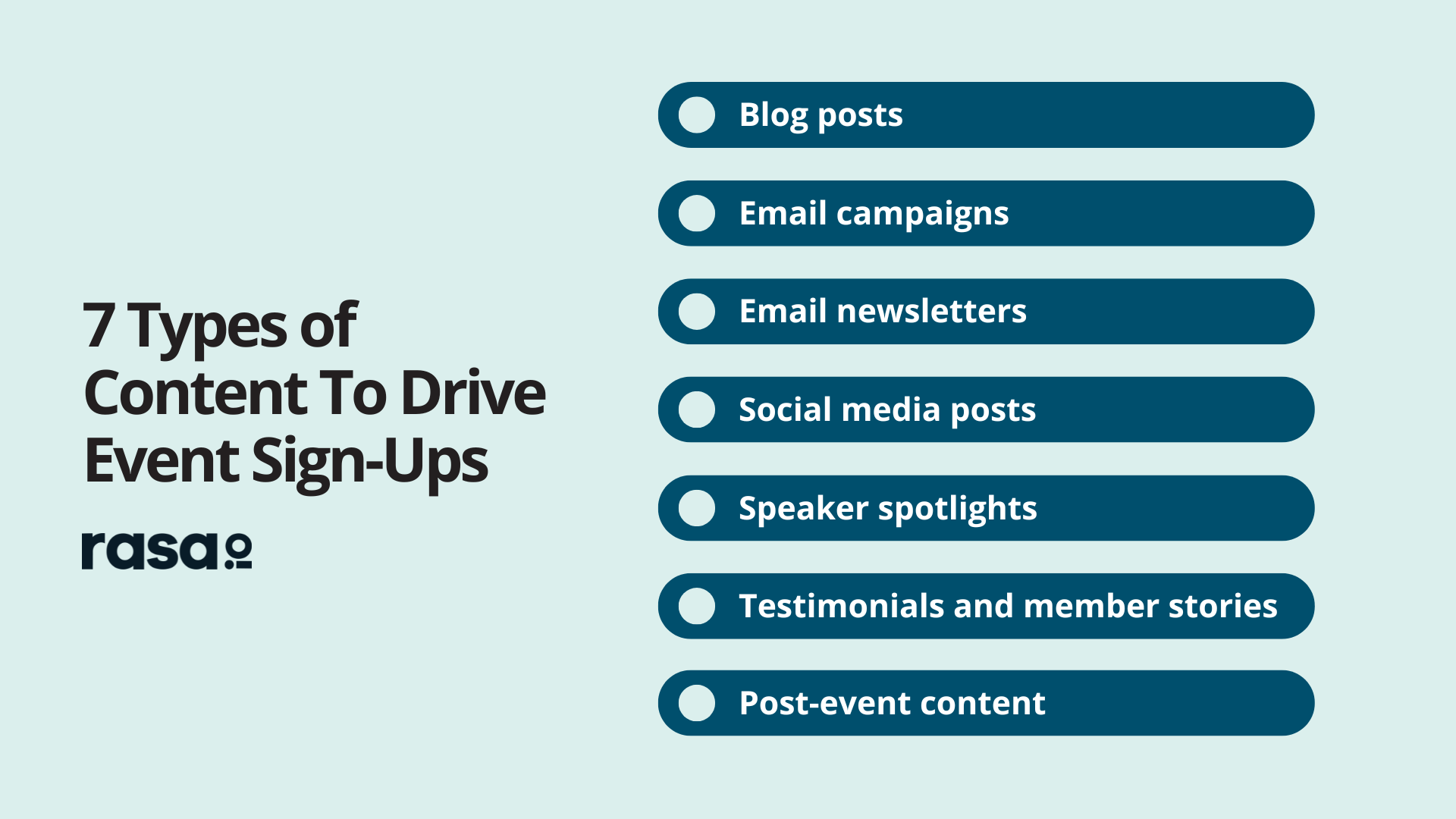If your association wants to increase event registrations, simply sharing the logistics isn’t enough. Even if your association’s event has strong speakers, an ideal venue, and highly relevant sessions, it can struggle to attract attendees without compelling marketing strategies.
From email campaigns and blog posts to social media campaigns and speaker spotlights, these strategies can help transform casual interest into committed attendance. Let’s explore the most effective types of marketing content to help drive sign-ups.
The Role of Content in Driving Event Sign-Ups
For associations, content educates, engages, and persuades your audience throughout the decision-making journey. An intriguing content strategy builds anticipation, answers questions, and motivates people to take action.
Each type of content serves a specific function in your event marketing strategy:
- Blog posts attract search traffic and establish the relevance of your event topics.
- Email campaigns deliver timely updates and strong calls to action directly to your audience.
- Email newsletters share relevant content consistently, such as new events, past recaps, etc.
- Social media posts build excitement, generate conversations, and keep your event top of mind.
- Speaker spotlights showcase thought leadership and motivate attendance.
- Post-event content extends the life of your event through recaps, highlight reels, and testimonials that can be used to nurture members and promote future events.
You can use these content mediums to meet your audience where they are and guide them toward registration. A thoughtful content approach increases sign-ups and builds deeper engagement with your members over time. Let’s further explore each type of content.
1. Email Campaigns
Email campaigns can convert potential attendees, especially when tailored to your audience. Plus, they give you direct access to your audience without relying on external information.
An engaging email stream for an event promotion campaign might look like this:
- Start by sending an engaging announcement that outlines the basics. Who should attend, what they can expect, when and where the event is happening, and why it matters. Make sure the registration link is easy to find and the call to action stands out.
- As the event approaches, build a short email series that offers increasing value. Instead of sending repetitive reminders, highlight key speakers, preview popular sessions, or offer exclusive member benefits to incentivize early sign-ups.
- After the event, send a short series of emails recapping it, thanking attendees, and asking for their feedback. These might be sent immediately after the event or later, once you better understand its wider impacts.
2. Email Newsletters
Email newsletters are a great way to promote your events consistently and build ongoing relationships with your audience. They keep your organization top-of-mind between events and provide regular touchpoints to share valuable content.
An effective newsletter strategy for event promotion might look like this:
- Weekly newsletters that feature upcoming events alongside other valuable content like industry insights, member spotlights, or educational resources. This positions your events as part of a broader value proposition rather than standalone promotions.
- Event-focused newsletter editions sent 2-3 weeks before major events. These can dive deeper into speaker backgrounds, detailed session previews, networking opportunities, or behind-the-scenes content that builds excitement and anticipation.
- Follow-up newsletter content that extends the event experience by sharing key takeaways, photo highlights, speaker resources, or announcements about future related events. This helps maintain engagement momentum after the event ends.
As you create your newsletter content, remember that not every member needs the same messaging, and personalized content resonates more. To easily deliver personalized messaging, consider using segmentation or AI to segment your list by interests, past attendance, or user behavior.
Create Personalized CTAs With AI
With the rasa.io’s Campaign tool, create email campaigns
tailored to each individual.
3. Blog Articles
Blog content plays a powerful role in your event marketing strategy by attracting new visitors through search and reinforcing the value of your event for existing members. Writing about topics that align with your event’s theme helps generate organic traffic and positions your association as a trusted resource in your industry.
You can use blog articles to preview the event in creative ways. For instance, you could feature interviews with keynote speakers, explore trending topics that will be discussed, or highlight why certain event sessions are especially relevant right now. These posts not only build awareness but also help potential attendees see the value of participating.
Each event-related blog post should include a natural call to action leading readers to your event registration page. Rather than a generic “sign up now,” use a context-driven approach, such as “Join us for a deeper dive into [topic] at this year’s annual conference.” This approach keeps your content informative and persuasive without coming off as overly promotional.
4. Social Media Posts
Social media is ideal for building momentum and keeping your event top of mind as it approaches. It’s best for sharing frequent, engaging updates that showcase what makes your event worth attending. Keep these best practices in mind:
- Visual content tends to perform best, so consider using graphics, speaker photos, and short video clips to highlight sessions or behind-the-scenes moments.
- Create a countdown series to remind followers how soon the event is happening, or spotlight individual sessions to build curiosity. Posts that feature past attendee experiences or quotes can also help generate interest, especially if they include a strong visual element.
- Encourage sharing by using an event-specific hashtag and inviting members to tag colleagues or friends who should attend. These small touches can go a long way in expanding your reach and drawing in more registrations.
5. Speaker Spotlights and Interviews
Featuring your event speakers can significantly enhance the perceived value of your event and provide potential attendees with compelling reasons to register. Speaker spotlights—whether in written form or short video clips—are an effective way to introduce key presenters and give a sneak peek into the insights they’ll share during their sessions.
You might consider publishing short Q&A interviews, detailed bios, or behind-the-scenes content that shows their preparation process. Share these spotlights across multiple channels—such as your blog, social media, and email newsletters—to maximize visibility. When your audience sees that well-known and respected industry experts are involved, they’re more likely to view your event as a valuable opportunity worth their time and investment.

6. Testimonials and Member Stories
There’s no better way to build trust than by showcasing the voices of past attendees. Getting Attention suggests using testimonials and member stories to highlight the value of your event in an authentic, relatable format. Whether it’s through quotes, short videos, or photo slideshows, these firsthand accounts help prospective attendees understand what they can expect and why others found it worthwhile.
Keep in mind that content doesn’t need to be overly polished. In fact, candid quotes and casual images often feel more genuine. Share these stories across key touchpoints, like your event landing page, blog posts, social media, and email campaigns, to cultivate community and credibility.
Whenever possible, spotlight testimonials from individuals in similar roles or industries to the audience you’re targeting. This makes the message even more relevant and persuasive, helping potential attendees see themselves in your event.
7. Post-Event Content
Your content strategy shouldn’t end when the event does. A2Z recommends leveraging post-event content to close the loop with attendees while extending the life of your event and creating a springboard for future registration campaigns. Recap blogs, highlight reels, and member testimonials from the event can all be repurposed to showcase the event’s success and build excitement for what’s coming next.
Share highlights across your digital channels to maintain visibility and keep your audience engaged. Feature key moments, popular sessions, or standout quotes from speakers. Not only does this content celebrate your event, but it also provides social proof that can encourage others to attend next time.
Wrapping Up
Driving event registrations is the result of a consistent, intentional content strategy that builds trust and excitement over time. By using a mix of content, your association can create a steady stream of interest that converts into actual sign-ups.
Whatever direction your content strategy eventually takes or the purpose of your event, the key is to meet your members where they are, provide value at every stage, and guide them toward action. With the right content strategy in place, your next event won’t just fill seats; it will deepen engagement and strengthen your community.













